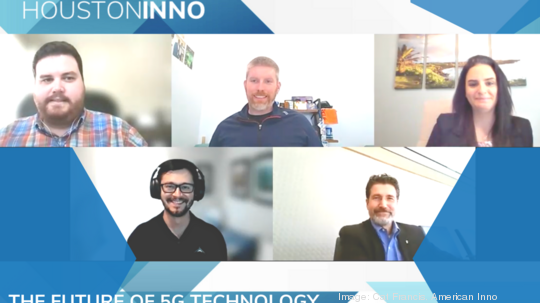
The future of 5G has arrived, but many businesses are still struggling to find their place within the digital and edge computing transformation. That hasn’t stopped tech-savvy companies and entrepreneurs from seizing its potential.
As industry leaders contemplate the impact of 5G on their businesses, others are already in the midst of tapping into or deploying these networks to take advantage of their low-latency, higher bandwidth and IoT capabilities — fueling new business models and innovation for tomorrow.
Houston Inno's virtual State of Innovation: The Future of 5G Technology explores the edge computing revolution with a panel of Houston-based technology experts. Moderator Heather Rex, of Intel Corporation, was joined by Brian Richards, Managing Director, Houston Innovation Hub Director Accenture; Werner Schaefer, VP/GM Network Platforms & Communications Services Provider Sales, Intel; and Ryan Guerra, Founder & CEO of Skylark Wireless, to discuss the industry shift.
The experts weighed in on the rapid acceleration of 5G and the implications for startups and businesses as the communications industry opens the door to this new frontier.
A full video recap appears below, but we’ve provided a few highlights from the conversation, below.
Can you introduce yourself and tell us how your business or role can leverage 5G technology to fuel your business transformation?
Brian Richards: I’m a managing director for Accenture here in Houston, [and] I founded and run our Houston Innovation Hub. It’s a little over 100 folks, data scientists, designers, developers and we take ideas from whiteboard to scale. I’ve spent my entire career focused on innovation. One of the things we’ve been doing this year has been very heavily focused on 5G. So, we actually have been partnered with telecoms companies to build out a true millimeter wave 5G network here in our office, testing out edge computing and other things to get toward the core value cases and opportunities for our clients to really utilize 5G in their own businesses.
Ryan Guerra: Ryan Guerra, co-founder and CEO of Skylark Wiress. We are a Houston startup that spun out of Rice University to go commercialize core 5G technologies, and we focus on building long range 5G base stations and user equipment for the rural broadband market.
Werner Schaefer: Working for Intel, I’m responsible for our global communications segment, so we provide silicon to our partners out there that build, on one hand, the infrastructure that we’re all using for this. On the other hand are the operators and managing it and rolling it out. I’m excited about ‘How do we innovate with these new capabilities we have here?’ 5G is a gamechanger. Providing solutions that enable this technology changes industries and frankly, how we collaborate, how we work, and how we live around the world.
Why should the non-technical consumer or business person be excited about 5G?
Richards: I think throughout my entire life, we’ve seen the convergence of greater processing power, greater bandwidth leads to net new innovation. And if you think about when we went from 3G to 4G, it opened all softs of new business models. It made it possible for Netflix to stream on your phone, for Uber to do real-time visualization of where a vehicle was. It allowed you to change your plane ticket. When I look at 5G, there’s three things that get me excited: it’s higher bandwidth, more devices that can connect and lower latency. And what that means for me is net new business models around autonomous vehicles, the Internet of Things for industrial applications, or otherwise thousands of sensors for streaming information. It’s still early but what are those new net businesses that 5G is going to create that are unlike we’ve seen?
Guerra: When I think of business opportunities for 5G, the question isn’t why do I need high speed fiber like broadband … but what are the applications that I can build once that’s available to everybody? If I’m the end user, I’m looking forward to having dead spots go away. High speed broadband coverage is spreading from the city now to rural markets and actually meeting the needs of everybody in America, not just folks in the middle of New York City.
Schaefer: It’s really the innovation that can come out of that. If you’re a technologist, [and] you look at what industry you’re in today, if you’re in manufacturing, in healthcare, try to dive into the capabilities. The low latencies, the bandwidth, the speed that is now available that may enable you to work on things that you weren’t able to before. Look at the whole ecosystem that surrounds 5G. What is there for you to bring new solutions, new ideas, and capabilities to your industry?
With any breakthrough technology, it’s obviously critical to be out of the gate fast. How is your business or how are you helping businesses lead in the 5G race?
Guerra: We founded Skylark to essentially democratize 5G technology. And so we focus primarily on long range opportunities to leverage all of these technological benefits and design these networks and solutions holistically for suburban and rural 5G applications. We do that through innovating new technologies on top of the wireless standards, as well as developing open resolution. We view this transition from 4G to 5G as opening up the door to some disruption of your traditional OEMs in terms of providing whole network solutions in the 5G space.
Schaefer: Our world is technology as an infrastructure provider. Obviously, we’re driving the open radio access. On the other hand, we power about 50 percent of base stations around the world for 5G now in collaboration with our large partners like Nokia and Ericsson. It’s fantastic to see how the democratization of the network is fueling this innovation and how even [traditional players] are diving in. We’re working on all levels with all of these companies to make sure the ecosystem really flourishes around 5G.
Richards: We’re spending a lot of time building out our own 5G network. We’re only the second one in Texas privatized 5G network. We learned a lot from that and the partnerships with the cloud companies here are very important … the Amazons, Microsofts, and Googles of the world, who are all building their own edge compute stack … And I find it funny how we go from mainframe to client server, to the cloud, and now ‘Let’s push it to the edge.’ It’s the Wild, Wild West to an extent. That’s what makes it so exciting.
What are some of the key challenges that your business or clients are seeing when it comes to 5G expansion and adoption?
Richards: Talent is always one, Finding the folks that can really do it is probably the singular, biggest challenge. Figuring out the what. It seems simple, [rely on] the use cases. But to some people ‘it’s going to be robotics. Is it XR, could it be AI? What do we need to go do? Where are we going to get the money?’ And if any senior level business is asking that question … ‘Do I take that risk, drive that innovation and be a first mover, or am I waiting for broad adoption?’ It depends on the company and the business. That’s going to justify the cost?
Guerra: One of our core missions is to bring the benefits of 5G to the rural market. And so for all the applications we’ve been talking about, it doesn’t do any good. If those applications only work in the city, and the moment you drive a little bit further out into rural Texas, all my applications stop working. My self-driving car doesn't drive anymore or slows down.We want these applications to be available on-demand everywhere in the world. So, we focus on ‘How do we take those technologies and build them holistically to support long-range rural applications and early challenges?’ Making sure this ecosystem is seamless wherever you go is one of the challenges that systems integrators, network operators, and everybody is going to have a hand in.
Schaefer: I have to jump on what Ryan said about autonomous cars slowing down or stopping. That’s where we have to continue developing. Where do you actually stop with that connectivity? How much computing, how much intelligence do I have to have for something to be self-containing even if I lose connectivity. Back to Brian, we are all fishing in that same talent pool. We really need to have everybody join us in these opportunities to develop talent, in your own company, with the help of community colleges, universities, to make sure we’re learning more about these technologies, and then we infuse with artificial intelligence [because] these areas will be the future.
What are some of your closing thoughts on 5G? What's one thing the audience needs to take away?
Schaefer: I think the first one is that a lot of people look at this as just another phone standard. We had 2G, 3G, 4G, and are moving on along, and it’s just going to be faster maybe. That this is not a real game changer. But now we’re getting into an era where you can use wireless technology to run your manufacturing environments. [There are] private wireless networks that can actually take care of your company. The savings there are enormous, and we need to open the minds of people to [show] there is so much more in those capabilities with 5G than just another phone standard. I think the message is really clear. Embrace it. It's here, it's rocking and rolling. And if you're a technologist and whatever industry you're in today, spend some time figuring out, you know, what's around the curve.
Richards: There are two things for me. There’s a business misconception. There’s the technology misconception. It's not surprising that we’ve marketed 5G out there. So a bunch of people see 5G on their phones and think they’re experiencing 5G and they’re not. So, from a technical standpoint, true millimeter wave 5G is mind blowing. Our 5G network is like one point two gigs down 450 megs up. If you've never experienced that on your phone … gigs of data in the snap of a finger, it’s crazy. But there's a technical trade off to that, which is we're using different frequency bands. It doesn't go through walls and things quite in the same way. That requires spending more time and really thinking about the customer, thinking about the client, the experience that gets beyond the network technology.
Guerra: On the technology side, it really is the perception that 5G is a monolithic solution, that there's only one thing that 5G is bringing to the table. I think aside from Skylark, but for all the companies that are playing in the space, we're just getting started. You know, we're the nationwide 5G network. Build outs are not done yet. And those are only going to improve going forward. You know, there's a concrete pathway to performance improving across the board for everybody. And so over the next several years, you're going to see the capabilities in the applications that are available on 5G networks explode.
Richards: The thing that gets me really excited is playing around with our own 5G network here with AT&T and all of our different partners. But when I look at the future and say, ‘Where would I want others to focus?’ It's the intersectionality of big problems the world faces and what is 5G role in that? And so health access when it comes to things like the energy transition.My hope is that we're not just creating a faster version of, you know, of watching Netflix. I'm hoping that it will bring the innovation to unlock solutions around some of these big societal challenges.





